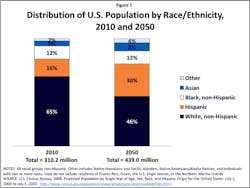Hispanics and oral health: What dental hygienists must know
According to U.S. Census data, minorities now comprise roughly one-third of the U.S. population, and it is anticipated that these groups will be in the majority by 2042. It is projected that more than half of all children in the United States will be from minority groups by 2023. Last year, the American Dental Association published two articles on the results of a study, The Hispanic Community Health Study/Study (HCH/SOL), which focused on the oral health status of Hispanic and Latino populations. The study measured and recorded the prevalence and number of decayed and filled surfaces, missing teeth, dentate status, and periodontal health.
The findings included:
- The prevalence of decayed surfaces ranged from 20.2% to 35.5%, depending on Hispanic or Latino background.
- The prevalence of decayed and filled surfaces ranged from 82.7% to 87%.
- The prevalence of missing teeth ranged from 49.8% to 63.9%.
- Men had significantly more unrestored decayed surfaces than did women.
- Cubans had the highest number of missing teeth and Mexicans had the lowest.
- The distribution of demographic characteristics and risk factors varied significantly across Hispanic or Latino background.
- 80% of participants were born outside the 50 United States, and 77% indicated Spanish as their language of preference.
- The prevalence of periodontitis as categorized according to the modified CDC-AAP classification ranged from 51% for total periodontitis (mild, moderate, and severe) to 32% for moderate and 10% for severe
- Dominicans exhibited the highest prevalence of no disease, and Puerto Ricans had the highest prevalence of severe periodontitis
And on and on…..
A dental health-care professional (or, for that matter, any professional) interested in the oral health status of Hispanics and Latinos can read this study and further analyze the exhaustive amounts of data collected by the researchers. That is why this study captured my attention (as I hope it will capture yours) and is the best of its kind done thus far.
The rationale for learning about cultural differences lies not in the biology of disease but in our acceptance and understanding of the drivers of disease, which is unique to this patient population.
HCH/SOL is a multicenter study funded by National Heart, Blood and Lung Institute The National Center on Minority Health and Health Disparities, the National Institute on Deafness and Other Communication Disorders, the National Institute of Dental and Craniofacial Research, the National Institute of Diabetes and Digestive and Kidney Diseases, the National Institute of Neurological Disorders and Stroke, and the National Institutes of Health Office of Dietary Supplements.
The study population had representation from six subgroups of Hispanic and Latino origin, making it the largest and most diverse study of its kind. Statistical analysis and design took into account significant variables which could affect the results. For example, while only four communities in the United States were included, the design included probability sampling which is superior to the convenience samples utilized in previous studies. The study lasted three years and great care was taken to calibrate and recalibrate examiners throughout its duration.
I admire the collaborative efforts of the researchers in conducting a study, which has provided health-care practitioners and public health professionals with such substantial data. By example, they have shown how much can accomplished when different health-care professions acknowledge the importance of oral health in overall health. With this information, we can better understand the differences in our own cultures and engage in constructive dialogue to improve the health of our community; we can seek support to carry out programs to improve the health of Hispanics and Latinos; we can use the data to inspire original research to further explore the reasons behind the findings.
------------------------------------------
Other articles by Macri
- How to avoid burnout as a dental hygienist
- Drafting a thank you letter: It's important for hygienists to express gratitude
- The dental professional's role in HIV education: It's an ethical responsibility
------------------------------------------
In another forum I was asked why it is necessary to discuss ethnicity as it pertains to oral disease. We are, after all, human beings and the pathogenesis of oral disease is the same in every human being. There are bacteria in our mouths, and they cause disease that we must prevent. The challenges presented in preventing oral disease in Caucasians are identical to those in Hispanics.
The rationale for learning about cultural differences lies not in the biology of disease but in our acceptance and understandingof the drivers of disease, which is unique to this patient population. This is the subject of cultural competency which, in essence, is the ability to interact effectively with people of different cultures and socio-economic backgrounds.
The Department of Health and Human Services (HHS) Office of Minority Health (OMH) now offers a free, six-credit, comprehensive e-learning continuing education program for oral health professionals which seeks to give participants basic cultural and linguistic competency knowledge and skills so that providers can:
- Expand patient base by providing more culturally and linguistically appropriate care to a wider diversity of patients.
- Deliver a higher quality of care to help patients meet their oral health care goals, while honoring and respecting their cultural beliefs and practices.
- Decrease clinical errors that may arise due to cultural and linguistic differences in communication and differences in oral health literacy.
- Gain essential tools to help recognize and lessen the racial and ethnic health care disparities that persist in oral health.
Our world has changed very quickly, and we are only as strong as our weakest link. The oral health disparities which exist affect us all, not just those who are from minority groups or poor or uneducated. With the growing opportunities for careers in public health, wise dental hygienists will understand the importance of understanding the unique obstacles that face so many minorities.
Diana Macri, RDH, BSDH, MSEd, MAADH, is based in New York City and is the co-author of the hygiene blog Empire Hygeniuses. Currently she is an assistant professor at Hostos Community College and continues to practice in a multi-specialty practice in Staten Island. She is a strong advocate for the profession and seeks to promote its expansion and visibility.
About the Author

Diana Macri, RDH
Diana Macri is a registered dental hygienist in New York City and co-author of the hygiene blog Empire Hygeniuses. Currently she is an assistant professor at Hostos Community College and continues to practice in a multi-specialty practice in Staten Island. She is a strong advocate for the profession and seeks to promote its expansion and visibility. She practices and teaches in New York City, where she happily resides with her three sons.

